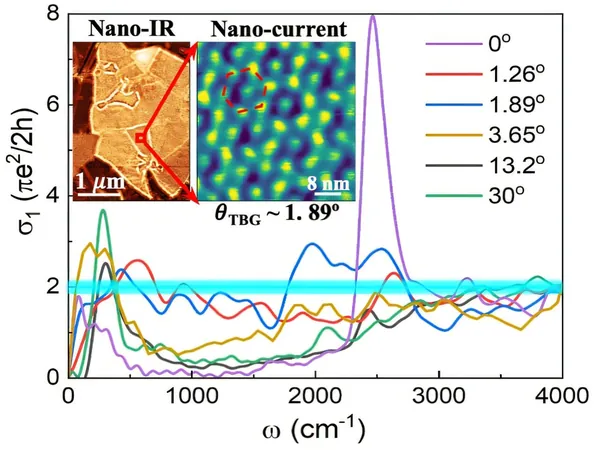
Unveiling the Secrets of Graphene: How Twists and Layers Revolutionize Optical Conductivity
2024-11-07
Author: Michael
Introduction
When it comes to the realm of nanomaterials, graphene stands out as a remarkable contender—its strength exceeds that of steel, and its electrical conductivity surpasses that of copper. This incredible material, made up of a single layer of carbon atoms arranged in a hexagonal lattice, is propelling advancements across various technologies.
Recent Research Findings
Recent research from physicists at Florida State University's Department of Physics, alongside the National High Magnetic Field Laboratory, has brought to light how manipulating graphene's structure—through layering and twisting—affects its optical properties and conductivity. These groundbreaking findings were published in the esteemed journal *Nano Letters*.
The Research Team and Methodology
Under the leadership of Assistant Professor Guangxin Ni, and in collaboration with colleagues Cyprian Lewandowski and Ty Wilson, the researchers discovered that the twists in bilayer graphene significantly influence its conductivity. Their experiments revealed that these characteristics remain largely resilient against physical and chemical alterations, suggesting that the material's electrical performance is influenced more by its nuanced geometric configuration than previously understood.
"Initially, we aimed to unravel the optical properties of twisted bilayer graphene," Wilson explained. "Existing studies had utilized scanning near-field optical microscopes but had not focused on varying twist angles. Our goal was to scrutinize the material from that distinct perspective."
Advanced Imaging Techniques
The team employed advanced imaging techniques to observe plasmons—minute waves of energy produced when electrons collectively move within the material. Utilizing a scanning near-field optical microscope, they directed infrared light onto the sample and captured images that went beyond conventional diffraction limits, revealing intricate nano-scale details.
Observations and Discoveries
The resulting images allowed the team to examine the grain boundaries, identifying distinct areas within the twisted bilayer graphene. These patches, where the carbon sheets were twisted at specific angles and aligned with layers of hexagonal boron nitride below, showcased a unique "double-moiré" structure—a fascinating interplay of patterns derived from the twisting layers.
"The aim was to compare the reflected near-field signals from various areas, but prior research largely focused on singular twist angles, often overlooking these complex moiré structures," Wilson noted.
Key Findings
Crucially, the researchers found that the optical conductivity in twisted bilayer graphene remains stable across angles of less than two degrees, irrespective of electrical doping or variations in infrared frequencies. This revelation could pave the way for tailor-made optical properties in multilayer moiré systems—materials that can meet specific technological demands.
Implications for Materials Science
"This finding opens up exciting avenues in materials science, showcasing how multilayer moiré systems can be engineered for desired optical traits," added Lewandowski. "The innovative measurement technique used by Professor Ni's team allows for exploration of the local optical responses in two-dimensional systems, complementing established measurement methodologies."
Future Research and Applications
The implications of this research are significant. Understanding the geometric effects on double-moiré lattices could help scientists enhance the optical characteristics of graphene, potentially leading to advancements in moiré optoelectronics. This includes applications in thermal imaging technology, optical switching for computational devices, and more.
"This study sets a strong foundation for our ongoing research into diverse nano-optical phenomena that traditional optics cannot achieve," Ni stated. As advancements continue to unfold, the future of graphene and its applications in technology looks more promising than ever.









 Brasil (PT)
Brasil (PT)
 Canada (EN)
Canada (EN)
 Chile (ES)
Chile (ES)
 España (ES)
España (ES)
 France (FR)
France (FR)
 Hong Kong (EN)
Hong Kong (EN)
 Italia (IT)
Italia (IT)
 日本 (JA)
日本 (JA)
 Magyarország (HU)
Magyarország (HU)
 Norge (NO)
Norge (NO)
 Polska (PL)
Polska (PL)
 Schweiz (DE)
Schweiz (DE)
 Singapore (EN)
Singapore (EN)
 Sverige (SV)
Sverige (SV)
 Suomi (FI)
Suomi (FI)
 Türkiye (TR)
Türkiye (TR)